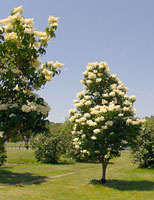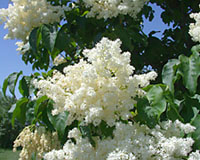Terry L. Ettinger Horticulture Consulting Services
Meeting The Needs Of Today With A Vision For The Future
Special Topics
Lilacs for Central New York Landscapes
Late-Blooming Tree Lilacs
 As surprising as it may be, the last lilacs don’t come into bloom here in Central New York until the very end of June!
As surprising as it may be, the last lilacs don’t come into bloom here in Central New York until the very end of June!
Native to China, the uncommon Pekin lilac (Syringa pekinensis or more recently recognized as Syringa reticulata ssp. pekinensis), for example, is a multi-stemmed shrub or small tree that can grow to a height and spread of fifteen to twenty feet.
From late June through the first week or so in July, it produces medium-sized panicles of creamy-white flowers that generally have little noticeable fragrance. In addition to its late flower habit, this lilac has reddish-brown/cinnamon-colored bark that can be quite attractive against a snowy backdrop throughout the winter months. Recently introduced, improved cultivars include `Beijing Gold’ (flowers that are reportedly more yellow than white), `China Snow,’ and `Summer Charm.’
And, last but not least, the Japanese tree lilac (Syringa reticulata ssp. reticulata), top of page, flowers reliably right at the very end of June through about the 10th or so of July across most of Central New York.
 While its enormous, creamy-white flowers, at left, are very showy, their fragrance is either pleasant (though not exactly lilac-like),
unpleasant, or nonexistent - depending upon who you ask.
While its enormous, creamy-white flowers, at left, are very showy, their fragrance is either pleasant (though not exactly lilac-like),
unpleasant, or nonexistent - depending upon who you ask.
The tree itself will be slightly larger (maybe twenty-five feet tall and twenty feet wide) than the Pekin lilac. And, instead of reddish-brown bark like the Pekin lilac, the Japanese tree lilac has shiny, charcoal gray bark that can also be quite effective during the winter months, at right.
The most readily available Japanese tree lilac cultivars are `Ivory Silk’ and `Summer Snow’ - both of which are quite similar in appearance.
In addition to their very late season of bloom, both of these tree-like lilacs are extremely drought-tolerant and cold-hardy once established, making them both very good choices for difficult, wind-swept landscape settings.